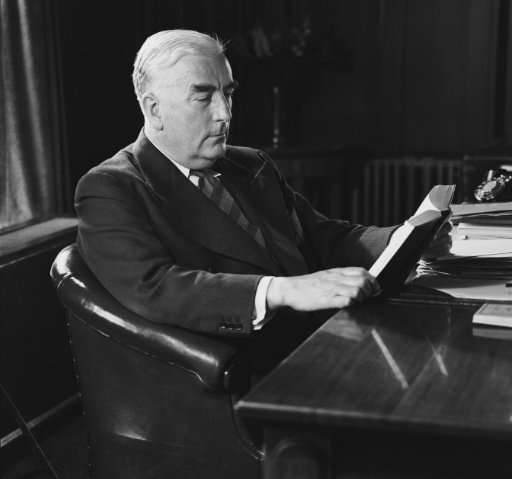On this day, 12 September 1939, the first and only budget Robert Menzies delivered as Treasurer begins the process of being examined by the Committee of Supply. Originally released just five days after Australia had been plunged into war with Nazi Germany, the budget’s central focus was on defence spending and war preparation, but as its details had been prepared before the outbreak of conflict Menzies warned that it would be subject to drastic revision.
Menzies’s decision to appoint himself as Treasurer on becoming Prime Minister in April 1939 was somewhat surprising. Menzies had no experience in the role and his interest in economic problems was limited; later describing himself as ‘no economist’. Because the Country Party had refused to form a Coalition Government with the UAP, Menzies was limited in terms of people he could choose to fill his Ministry, but that did not stop him from appointing a Cabinet of sixteen members which was then the largest in the history of the Commonwealth Government.
Moreover, Menzies had an obvious candidate for Treasurer in Richard Casey, who had been serving in that role since 1935 and who did have a keen interest in economics. Casey had been a rival to Menzies in the recent leadership contest that followed the death of Joseph Lyons, but since Casey had received less votes than the 76-year-old Billy Hughes he was arguably not much of a threat (though he had been involved in an attempt to convince Stanley Bruce to re-enter politics to take up the Prime Ministership and this would surely have not endeared him to Menzies).
Casey was instead made Minister for Supply and Development, a new department which would play a crucial role in arming Australia for what was looking like an increasingly inevitable war, and it was likely because Menzies wanted to control where limited resources were allocated during this war preparation phase that he made himself Treasurer. Menzies had a precedent in Joseph Lyons, who likewise took on the dual role of Prime Minister and Treasurer to deal with a national crisis. Beyond creating the Department of Supply, other prescient moves of defensive preparedness involved setting up a compulsory National Register of manpower, the reintroduction of compulsory military training, and expanding the Defence Act to allow service in Australian Territories and Mandates such as New Guinea. At the time, the Labor Opposition fiercely attacked these moves and accused the Government of attempting ‘to create and foster war hysteria’.
With the defence imperative, Menzies’s budget was the largest in the history of the Commonwealth and introduced sharp increases in income, company and sales taxes, as well as duties on petrol, alcohol and luxury goods, but Menzies emphasised that even more spending and consequent sacrifices were soon to come:
‘This is the first budget that I have had the honour to present to this Parliament, and I wish that it could have been presented in different circumstances. Indeed, the circumstances in which I do present it to the committee are such as to render it quite inevitable that the budget itself, and also the Estimates upon which it is based, must be subject to revision, perhaps very drastic revision, during the course of the financial year. It is, perhaps, indicative of the extraordinary changes that have taken place in our conception of the functions and responsibilities of government, and in the burdens which are imposed upon governments at a time of trial like this, that whereas Gladstone, who presented no less than thirteen budgets to the British Parliament, had to wait, so to speak, until near to the end of his career to present to the Parliament his first £100,000,000 budget, I have the unhappy distinction this year of presenting to the Commonwealth Parliament a £100,000,000 budget for the first time in the history of the Commonwealth, and that in relation to a country whose population is a mere fraction of the population of Gladstone’s England.’
The ‘drastic revision’ Menzies foreshadowed would come in the form of an updated budget, delivered and prepared by Assistant Treasurer Percy Spender in late November. This was both innovative and controversial, as it relied not just on increased taxes and borrowing to fund the war effort, but also an injection of central bank credit that was an early instance of Keynesian budgeting. Spender would take on the full Treasurer position in March 1940 as Menzies found his commitments as wartime Prime Minister were more than enough for a single man (indeed in the lead up to the budget the Melbourne Herald ran an article with the headline ‘Mr. Menzies Hardest Worked Man in Australia’).
Further Reading:
John Hawkins, ‘Menzies: treasurer in transition to war’, Economic Round-up Issue 1 2011, Department of the Treasury, Menzies: treasurer in transition to war | Treasury.gov.au
John Hawkins, ‘Percy Spender an early Keynesian’, Economic Round-up Issue 2 2011, Department of the Treasury, Percy Spender an early Keynesian | Treasury.gov.au
Sign up to our newsletter
Sign up for our monthly newsletter to hear the latest news and receive information about upcoming events.


